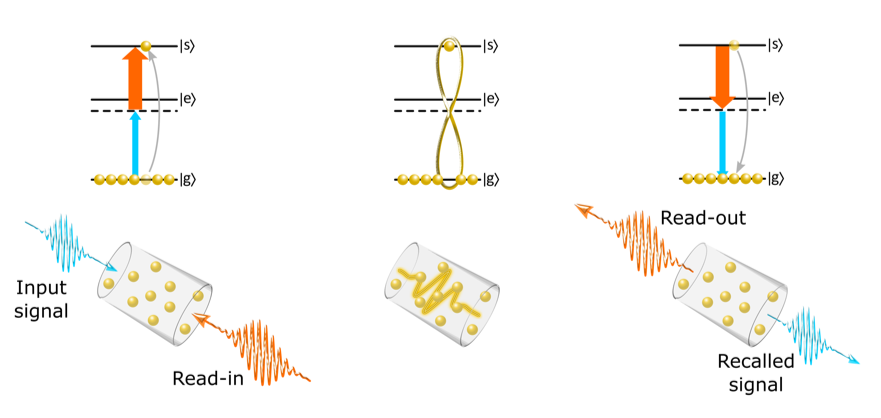Our research focuses on the development and implementation of a quantum optical memory (see here for a recent review article). This is a device that can take a quantum state of light (e.g. a single photon), store it for an arbitrary length of time, and recall the state efficiently in a noise-free fashion, preserving the quantum nature. A quantum memory would bring clear and immediate impact to the quantum information processing community for large-scale quantum networking, particularly, being useful in the context of quantum computation and the Quantum Internet. For accessible talks on these subjects, check out Prof Shohini Ghose’s Tedx Talk and Prof Stephanie Wehner’s Tedx Talk, respectively.

Platforms for Quantum Memories
Atomic based systems provide a platform for the implementation of quantum optical memories. An atom or an atomic ensemble absorbs the quantum state of light, storing it as an atomic coherence which can be read out back to a light field at a later time defined by the user. An on-going challenge is to implement this efficiently, free of noise, with broad acceptance bandwidth and long storage time.
Rare Earth Ion Doped Solids

An attractive platform for realising a quantum optical memory is rare earth ion doped crystals. The triply ionised rare earths are doped within a solid state matrix, where the optical transitions occurring within a partially filled 4f shell spatially reside within an effective Faraday cage provided by a full 5p shell. The result is that an individual ion has narrow homogeneous line (~1 kHz) which leads to long coherence times, provided that the system is reduced to a cryogenic temperature to negate dephasing via phonons. Coherence times of several hours have been measured in these systems, providing great prospects for quantum communication applications.

The optical lines of ensembles of ions are susceptible to inhomogeneous broadening due to the crystal field. This motivates the use of memory protocol based on rephasing mechanisms, for example, the Atomic Frequency Comb (AFC) protocol. AFC uses complex spectral holeburning techniques to shape the inhomogeneously broadened line into a comb-like structure. The comb can then absorb a photon, and at a time given by the inverse of the comb tooth separation, the photon will be reemitted. Given the narrow homogenous lines rare earths have, long AFC delay times (several microseconds) are possible. The full AFC protocol combines this delay with an on-demand aspect: before the photon is re-emitted by the AFC, a control pulse maps the optical coherence to a spin-wave coherence, then at a user-defined time later, a second control pulse does the reverse mapping, allowing the photon to finally be emitted. This full AFC protocol has been used to demonstrate storage and retrieval of time-bin qubits, polarisation qubits, and heralded single photons.
Atomic Vapours

Atomic vapours provide a platform to implement these memories. Alkali gases have strong dipole moments combined with high atomic densities, resulting in large light-matter coupling. The high efficiencies, high bandwidths, and operation at ambient temperatures provide a scalable platform for fast quantum memories in a quantum network.
In the context of local quantum networks, a high repetition rate is desirable and therefore broadband realizations of quantum memories are required. Off-resonant Raman-based memory protocols are capable of broadband operation – e.g the Raman quantum memory (based on the Raman effect phenomenon, discovered and pioneered by Sir Chandrasekhara Venkata Raman). The memory is characterised by two optical fields, signal and control, that are in a lambda configuration. The fields are detuned off single-photon resonance but are on two-photon resonance. The strong control pulse dresses the atomic system providing a broad virtual state to which the signal field couples efficiently to, with the bandwidth being determined by that of the control pulse. A single photon can then be mapped to the entire ensemble, being stored in a collective coherence or spin wave, which is then read out later with a second control pulse.
An outstanding challenge with the Raman memory is the inherent four-wave mixing noise introduced at the output as a result of the strong control pulse driving the populated transition and creating spurious spin-waves via Stokes-type scattering. This has proven detrimental for single photon storage in both vapour and bulk diamond systems. To negate this effect, we have used vapours in cavities to suppress the Stokes-type scattering and a novel built-in noise suppression scheme, the latter work presenting a comprehensive analysis of the noise contributions in Raman memories.

An approach we’ve pioneered is to move away from a Lambda configuration and toward a ladder one, utilising the Off-Resonant Cascaded Absorption (ORCA) protocol. The key benefit of ORCA is the ladder scheme itself – an arrangement with significant wavelength separation between signal and control leads to the elimination of control field induced scattering or fluorescence noise inherent in Lambda schemes. Combined with high-quality low-loss interference filters for suppression of the control pulse leakage allows ORCA to perform at the highest signal to noise ratio demonstrated and store single photons without altering the quantum features of it. The ladder configuration also allows flexibility in choice of transition, opening up compatibility with semiconductor quantum dot sources, and as a further application, the ORCA memory interaction is capable of coherent filtering of temporal-spectral noise associated with quantum dot sources.
